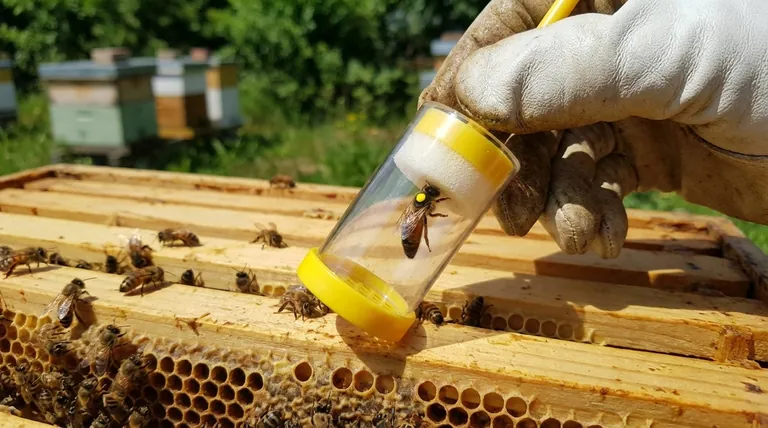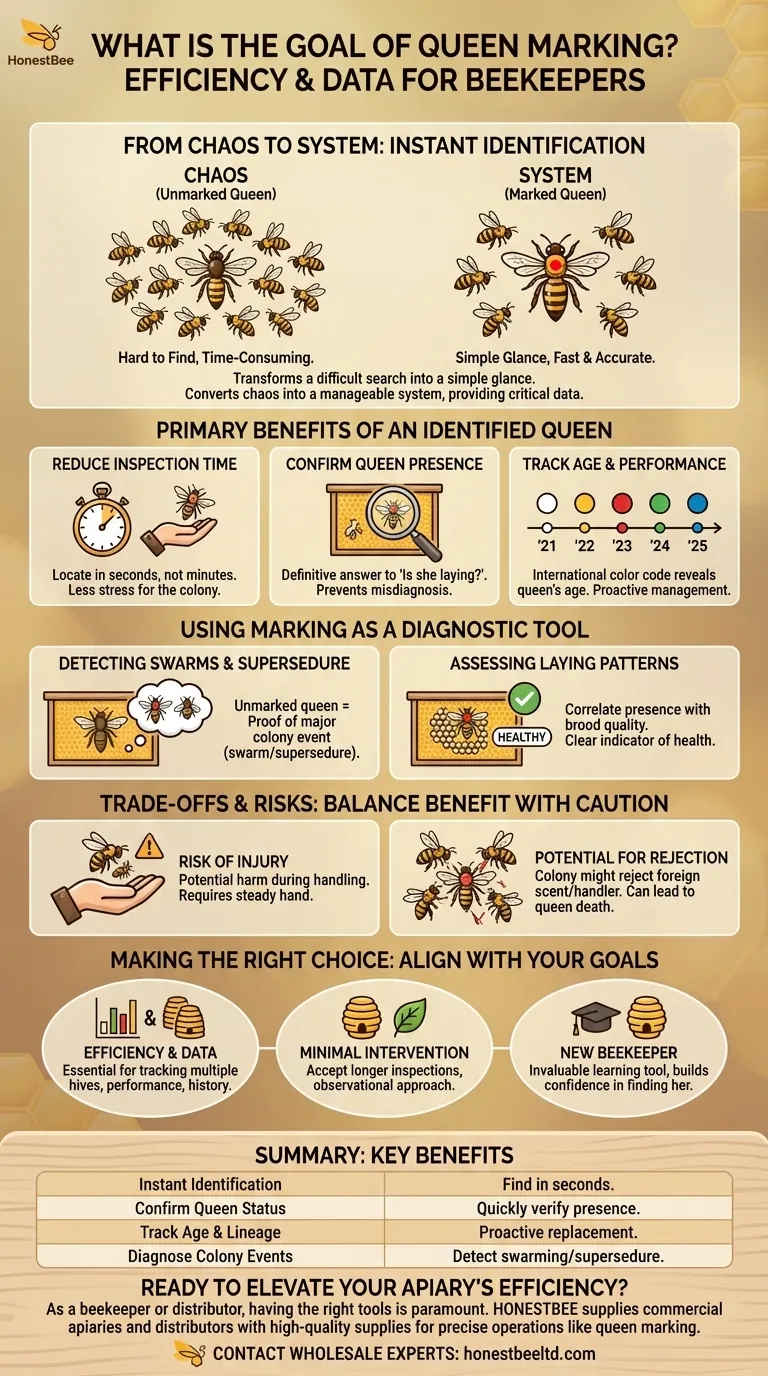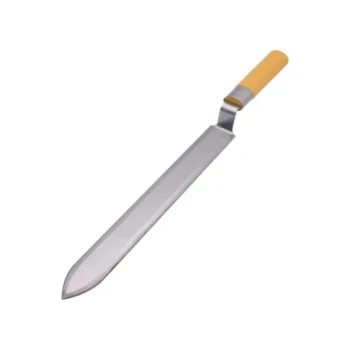At its core, the goal of queen marking is to make the single most important bee in the colony instantly identifiable. By placing a small, colored dot on her thorax, a beekeeper transforms a difficult search into a simple glance, enabling faster, more accurate assessments of the entire colony's health and status.
Queen marking isn't just about finding the queen; it's about converting the chaos of a 50,000-bee colony into a manageable system. The mark serves as a unique identifier that provides critical data on the queen's age, presence, and lineage at a single glance.

The Primary Benefits of an Identified Queen
The simple act of marking a queen unlocks a new level of management efficiency and diagnostic capability. It fundamentally changes how you interact with and understand the colony.
Drastically Reducing Inspection Time
Finding one specific bee among tens of thousands of her nearly identical daughters can be a time-consuming and disruptive process. A marked queen can often be located in seconds, whereas finding an unmarked queen can take many minutes, causing unnecessary stress to the colony.
Confirming the Queen's Presence
The most critical question during any hive inspection is, "Is the queen present and laying?" A marked queen provides a definitive answer. If you can't find her, you can be much more certain that the hive is queenless and needs immediate intervention, preventing you from mistakenly "requeening" a colony that already has a viable, unmarked queen.
Tracking Age and Performance
Beekeepers use an international color code that assigns a specific color to each year. This allows you to know the queen's age just by seeing the color of her mark. Since a queen's egg-laying productivity typically declines after two or three years, knowing her age is crucial for proactively managing colony performance and deciding when to replace her.
Using Marking as a Diagnostic Tool
A marked queen is more than just an easy-to-find bee; she is a living data point that reveals the hidden history of the colony.
Detecting Swarms and Supersedure
If you inspect a hive and find an unmarked queen, but you know you previously had a marked one, you have definitive proof of a major colony event. This indicates the original queen either left with a swarm or was replaced by the workers in a process called supersedure. Without a mark, you might never know this change occurred.
Assessing Laying Patterns
Once you quickly locate the queen, you can more easily evaluate her work. A healthy queen will have a compact, solid brood pattern around her. Finding the queen allows you to directly correlate her presence with the quality of the brood, giving you a clear indicator of her health and fertility.
Understanding the Trade-offs and Risks
While highly beneficial, marking a queen is an active manipulation that is not without risk. Objectivity requires acknowledging these potential downsides.
Risk of Injury
The most significant risk is accidentally harming the queen during the process of catching and marking her. An injured leg, antenna, or—in the worst case—a crushed thorax can lead to her death and the immediate decline of the colony. This requires a steady hand and a calm demeanor.
Potential for Rejection
Occasionally, the colony may react negatively to a queen that has been handled and painted. The foreign scent of the paint or the handler can cause the workers to see her as an intruder, leading them to reject and kill her—a process known as "balling."
Is It Always Necessary?
For beekeepers with only a few hives and a "minimal intervention" philosophy, marking may be seen as an unnecessary intrusion. They may prefer the slower, more observational approach to hive management, accepting the trade-off of longer inspection times.
Making the Right Choice for Your Goal
Deciding whether to mark your queen depends entirely on your beekeeping objectives and management style.
- If your primary focus is efficiency and data: Marking is an essential practice for tracking queen age, performance, and colony history, especially when managing multiple hives.
- If your primary focus is minimal intervention: You may choose to forgo marking, accepting that inspections will require more time and careful observation to confirm the queen's status.
- If you are a new beekeeper: A marked queen is an invaluable learning tool that builds your confidence in finding her and connecting her presence to the overall health of the colony.
Ultimately, marking a queen is about transforming uncertainty into actionable information, empowering you to make better, faster decisions for your bees.
Summary Table:
| Goal | Key Benefit |
|---|---|
| Instant Identification | Find the queen in seconds, not minutes. |
| Confirm Queen Status | Quickly verify presence and prevent misdiagnosis. |
| Track Queen Age & Lineage | Use the international color code for proactive replacement. |
| Diagnose Colony Events | Detect swarming or supersedure with certainty. |
| Assess Laying Performance | Correlate the queen's presence with brood pattern health. |
Ready to elevate your apiary's efficiency and data-driven management?
As a beekeeper or distributor, having the right tools is paramount to success. HONESTBEE supplies commercial apiaries and equipment distributors with the high-quality, reliable beekeeping supplies needed for precise operations like queen marking and beyond.
Let us help you build a stronger, more productive operation. Contact our wholesale experts today to discuss your specific needs and discover how our products can support your goals.
Visual Guide

Related Products
- Queen Bee Marking Tube Cage Bottle Catcher Holder with Clear Plastic Plunger Marker
- Plastic Queen Bee Catcher Marker Tube Holder for Queen Marking Bottle
- HONESTBEE Professional Long Handled Hive Tool with Precision Cutting Blade
- HONESTBEE Advanced Ergonomic Stainless Steel Hive Tool for Beekeeping
- Professional Dual-End Stainless Steel Hive Tool for Beekeeping
People Also Ask
- What are the advantages of marking a queen bee? Achieve Precision and Confidence in Hive Management
- How do you capture and immobilize a bee for marking? Master Safe Queen Handling for Your Apiary
- What is the purpose of marking a Queen bee? Boost Hive Management with Instant Identification
- What tools and skills are needed to mark a queen bee? Master the Art of Safe & Effective Queen Marking
- How does marking a Queen bee help in age tracking? Boost Hive Productivity with Clear Identification



















